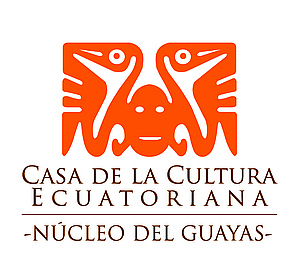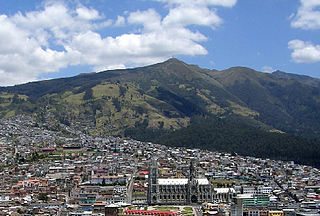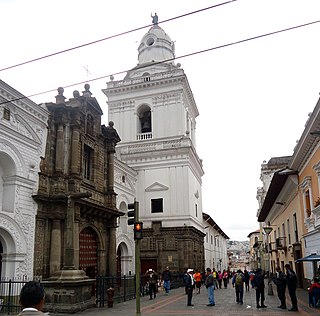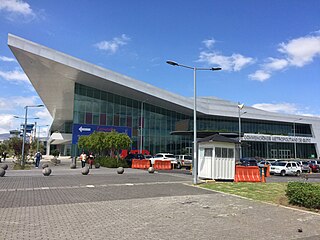
Quito, officially San Francisco de Quito, is the capital of Ecuador, with an estimated population of 2.8 million in its metropolitan area. It is also the capital of the province of Pichincha. Quito is located in a valley on the eastern slopes of Pichincha, an active stratovolcano in the Andes.

La Casa de la Cultura Ecuatoriana is a cultural organization founded by Benjamín Carrión on August 9, 1944, during the presidency of Dr Jose Maria Velasco Ibarra. It was created to stimulate, to direct and to coordinate the development of an authentic national culture. Headquartered in Quito, it maintains several museums throughout Ecuador.

Quito, officially the Metropolitan District of Quito, is a canton in the province of Pichincha, Ecuador.

Pedro Moncayo is a canton in the north of the Pichincha Province, Ecuador. The seat of the canton is the city of Tabacundo. The canton is named after politician Pedro Moncayo. The canton is separated by the Mojanda volcano from the canton of Otavalo in the province of Imbabura in the north. It borders the same-province cantons of Cayambe and Quito.

Puerto Quito is a canton in Pichincha Province, Ecuador. It has only one parish, the urban parish of Puerto Quito, which is also the seat of the canton.
Guayllabamba is a small agricultural town located 29 kilometers northeast of the city of Quito in northern Ecuador. In the 2001 census, the parish had a population of 12,227. The elevation is 2,142 metres (7,028 ft) above sea level.

Rumiñahui or Rumiñawi is a canton of Pichincha Province in Ecuador. Its seat is Sangolquí. The canton lies southeast of Quito Canton and forms a suburb of Quito.

The Central University of Ecuador is a national university located in Quito, Ecuador. It is the oldest and largest university in the country, and one of the oldest universities in the Americas. The enrollment at the university is over 10,000 students per year.
The Cotocollao Parish is a parish in northwest Quito, Ecuador. It is one of the biggest parishes of the city. The use of the area is primarily residential, however it also has a very active commercial zone around the Avenida de La Prensa and has the "El Condado" shopping mall.

Guápulo is a district of Quito, Ecuador, also called an electoral parish. The parish was established as a result of the October 2004 political elections when the city was divided into 19 urban electoral parishes. Set behind Hotel Quito, the neighborhood of Guápulo runs down the winding Camino de Orellana, from González Suárez to Calle de los Conquistadores, the main road out of Quito and to the neighboring suburbs. Often considered an artsy, bohemian neighborhood of Quito, Guápulo is home to many local artists and a couple of hippy cafés/bars. Every year on September 7 the guapuleños honor their neighborhood with the Fiestas de Guápulo, a fantastic celebration complete with costumes, parade, food, drink, song, dance, and fireworks.

Itchimbía is a hill in Quito, Pichincha Province, Ecuador. It is surrounded to the east by Machángara River, a river that originates in the southern part of the city of Quito. Itchimbía is on the eastern/northeastern border of the center (downtown) of the city of Quito and the southeast border of the northern part.

The Municipality of Quito is the governing body of the city of Quito and the Metropolitan District. Its headquarters are at the Municipal Palace, located on the east side of the Plaza de La Independencia

The Church and convent of San Agustín is a Catholic temple run by the Augustinian Order located in the Historic Center of Quito, Ecuador. The complex of the temple and convent is located on calle Chile, between Guayaquil and Flores.

The Pontificia Universidad Católica del Ecuador (PUCE) is a Pontifical Catholic university founded in 1946 in Quito, Ecuador.

La Iglesia de El Sagrario is a Renaissance Catholic Church in the city of Quito, capital of Ecuador. It is located in the Historic Center of the city, on calle García Moreno, formerly known as calle de las Siete Cruces, a few meters from the corner with calle Eugenio Espejo. It is part of the Metropolitan Cathedral complex, although it seems more like an independent church than an adjoining chapel, both because of its size and because of its importance in Quito's art.

Alberto Mena Caamaño Museum is a museum in Quito, Ecuador. A cultural institution of Quito, the capital of Ecuador, it is located in the historic center of the city, next to the Palacio de Carondelet. The Rough Guide to Ecuador considers it to be the "old town's most rewarding museum".

The City Museum is a museum in the colonial center of Quito, Ecuador. It is located on Garcia Moreno Street, between Morales and Rocafuerte.

Benjamín Carrión Palace is a palace and museum in Quito, Ecuador. Named after Benjamín Carrión, a diplomat, cultural promoter, and an Ecuadorian writer. The palace was built in 1946–8. The building is located in the district of Itchimbía, near the border with La Mariscal. Its south side is adjacent to El Arbolito and was one of the first structures completed in the complex of buildings which create the Cultural Center of Ecuador.

The Basilica of Nuestra Señora de la Merced, is a Catholic temple located in the Historic Center of the city of Quito, capital of Ecuador. It is the first church and headquarters of the Mercedarian Order in the country, and for this reason it bears the title of Basilica.

The Quito Metropolitan Convention Center (CCMQ), also known as the Bicentenario Convention Center, is a complex of municipally owned buildings that constitutes the main convention center of the city of Quito, Ecuador. The complex is located on the grounds of the terminal of the Old Mariscal Sucre Airport, surrounded by Bicentenario Park, in the parish of La Concepción, north of the Ecuadorian capital.
















